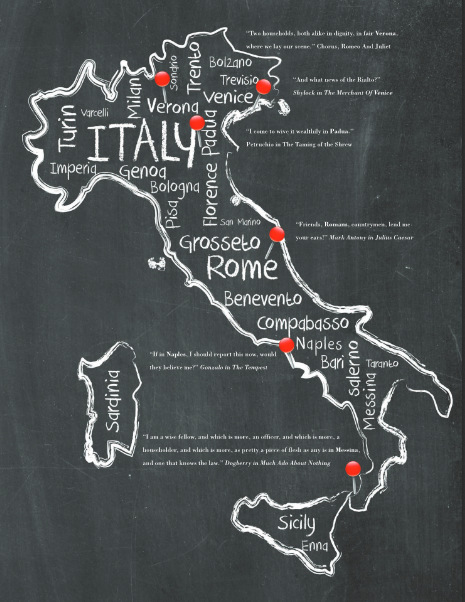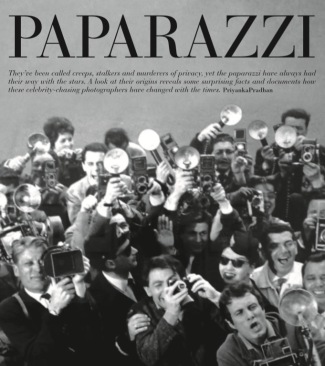Published in Sorbet Magazine (May 2014)
Best In Town
Shakespeare’s Italy
Although there is no evidence that William Shakespeare ever went there, his long-standing love affair with Italy has led some experts to suggest that he actually lived there for a while. Whatever the truth may be, there is no denying that the Bard’s plays are immersed in Italian culture and draped in the social fabric of the country, offering a unique guide to Italy.
Priyanka Pradhan
Rome
“Friends, Romans, countrymen, lend me your ears!”- Mark Antony in Julius Caesar
Of the 13 plays set in Italy, Shakespeare’s most intense political dramas, including Antony and Cleopatra, Julius Caesar and Coriolanus are placed against the backdrop of Rome’s daunting fortresses and menacing real-life conspiracies. Shakespeare’s classic Roman tragedies portrayed power, deceit and betrayal through strong Italian characters such as Marcus Brutus, a politician of the late Roman Republic, Pompey the Great, and Mark Antony, the Roman general who fell in love with that infamous Egyptian queen. However, in reality, the most imposing and intimidating of all was the city of Rome itself.
You can visit:
The Roman Forum (Forum Romanum): A rectangular plaza surrounded by the ruins of several important ancient government buildings at the centre of the city. Citizens of the ancient city referred to this space, originally a marketplace, as the Forum Magnum, or simply the Forum.
Padua
“I come to wive it wealthily in Padua”- Petruchio in The Taming of the Shrew
One of Shakespeare’s first plays set in Italy, The Taming of The Shrew explored the city of Padua through the eyes of its protagonists, Petruchio and Katherina. In Shakespeare’s time, Padua, a city and commune in the Veneto, northern Italy, was known to be the center of education throughout Europe. The first university in the world (Galileo and Casanova were counted among the alumni of the university) formed the epicenter of the city. Shakespeare used this reputation of Padua and the backdrop of the university as a setting for his play.
You can visit:
The University of Padua in the Palazzo del Bò, founded in 1222 as a school of law and was one of the most prominent universities in early modern Europe. The University also houses a wooden anatomical amphitheatre in the Medical School, built in the 16th century.
Venice
“And what news of the Rialto?”- Shylock in The Merchant Of Venice
One of Shakespeare’s most prolific plays, The Merchant of Venice, steers the spectator across the Venetian ghetto, the Rialto, the business district of Venice and the picturesque (and fictional) Belmonte, described as a beautiful port city near Venice. The narrative explores themes of love and friendship, while expertly navigating issues of feminism and racism in erstwhile Italian society against the backdrop of the beautiful canal city. Another play that offers a perspective of Shakespearean Venice as is The Tragedy of Othello: The Moor of Venice, which follows the eventual undoing of a general in the Venetian military through jealousy and betrayal.
You can visit:
A walk along the business district, the Rialto Bridge and the many city squares of Venice is a rewarding way to retrace the steps of Shakespeare. A traghetto ferry is another oft-quoted mode of transport in his plays.
Verona
“Two households, both alike in dignity, in fair Verona, where we lay our scene.”- Chorus, Romeo And Juliet
While Verona is much loved by honeymooners and hopeful singles, the quaint little town is rich in architectural and cultural sights. However, for most, it is synonymous with Juliet calling out to her Romeo from her iconic balcony. While the authenticity of ‘Juliet’s balcony’ at the Via Capello house remains to be seen (it was added as recently as 1936), it remains a popular hot spot. As a UNESCO World Heritage Site, Verona also boasts of a few non-touristic spots, such as quaint gardens, reflecting the typical Romanesque architecture of the town’s residential quarters.
You can visit:
Basilica di San Zeno Maggiore, which is believed to contain the crypt where Romeo and Juliet were married, as well as Juliet’s alleged tomb at the Capuccin Church. A walk down the cobblestoned pathways of the town will reveal beautifully conserved relics from medieval times.
Messina
“I am a wise fellow, and which is more, an officer, and which is more, a householder, and which is more, as pretty a piece of flesh as any is in Messina, and one that knows the law”- Dogberry in Much Ado About Nothing
Shakespeare’s comedy Much Ado About Nothing is set in the port city of Messina on the island of Sicily, which, at the time, was an independent kingdom ruled by kings of Aragon, a Spanish dynasty. The play, while humorous, also throws light on court politics, gender and class differences and the idea of honor amongst Sicilians. The bard described Sicily in dramatic stokes, peppered with witty repartee and dark humor. Much of the play’s scenes are set indoors, as Shakespeare endeavored to capture the ethos of the Sicilian kingdom, rather than the panoramic beauty of the island.
You can visit:
For those who believe that Shakespeare had Italian origins, Messina holds the key to a number of theories that suggest that he was born in Sicily. Otherwise, visitors can also see the 12th century Messina Cathedral and the Piazza del Duomo, which date back to the Norman times.
Naples
“If in Naples, I should report this now, would they believe me?” – Gonzalo in The Tempest
Thought by critics to mark the last play that Shakespeare wrote alone, The Tempest tells the story of Prospero, the rightful Duke of Milan, and his plans to restore his rights by placing his daughter Miranda on the throne. The tale of how he creates the titular tempest in his attempts to bring about the downfall of his brother Antonia and Kind Alonso of Naples takes place on a remote island in the Mediterranean.
The play ends with Prospero regaining his dukedom in the kingdom of Naples.
You can visit:
The Castel Nuevo, built in 1279, for its medieval architecture and its significance as the ‘new castle’ of King Charles I. A grand, white marble arch was built at the castle in 1443, to commemorate King Alfonso’s entry into Naples.



